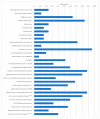Comparison of the Efficacy of Longer versus Shorter Pulsed High Dose Dapsone Combination Therapy in the Treatment of Chronic Lyme Disease/Post Treatment Lyme Disease Syndrome with Bartonellosis and Associated Coinfections
- PMID: 37764145
- PMCID: PMC10537894
- DOI: 10.3390/microorganisms11092301
Comparison of the Efficacy of Longer versus Shorter Pulsed High Dose Dapsone Combination Therapy in the Treatment of Chronic Lyme Disease/Post Treatment Lyme Disease Syndrome with Bartonellosis and Associated Coinfections
Abstract
Twenty-five patients with relapsing and remitting Borreliosis, Babesiosis, and bartonellosis despite extended anti-infective therapy were prescribed double-dose dapsone combination therapy (DDDCT), followed by one or several courses of High Dose Dapsone Combination Therapy (HDDCT). A retrospective chart review of these 25 patients undergoing DDDCT therapy and HDDCT demonstrated that 100% improved their tick-borne symptoms, and patients completing 6-7 day pulses of HDDCT had superior levels of improvement versus 4-day pulses if Bartonella was present. At the completion of treatment, 7/23 (30.5%) who completed 8 weeks of DDDCT followed by a 5-7 day pulse of HDDCT remained in remission for 3-9 months, and 3/23 patients (13%) who recently finished treatment were 1 ½ months in full remission. In conclusion, DDDCT followed by 6-7 day pulses of HDDCT could represent a novel, effective anti-infective strategy in chronic Lyme disease/Post Treatment Lyme Disease Syndrome (PTLDS) and associated co-infections, including Bartonella, especially in individuals who have failed standard antibiotic protocols.
Keywords: Lyme disease; babesiosis; bartonellosis; dapsone combination therapy (DDSCT); double-dose dapsone combination therapy (DDDCT); florescent in situ hybridization (FISH); high-dose dapsone combination therapy (HDDCT); persistent infection; post-treatment Lyme disease syndrome (PTLDS).
Conflict of interest statement
The authors declare no conflict of interest. The funders had no role in the design of the study, in the collection, analysis, or interpretation of data, in the writing of the manuscript, or in the decision to publish the results.
Figures
Similar articles
-
Combining Double-Dose and High-Dose Pulsed Dapsone Combination Therapy for Chronic Lyme Disease/Post-Treatment Lyme Disease Syndrome and Co-Infections, Including Bartonella: A Report of 3 Cases and a Literature Review.Microorganisms. 2024 Apr 30;12(5):909. doi: 10.3390/microorganisms12050909. Microorganisms. 2024. PMID: 38792737 Free PMC article.
-
Efficacy of Double-Dose Dapsone Combination Therapy in the Treatment of Chronic Lyme Disease/Post-Treatment Lyme Disease Syndrome (PTLDS) and Associated Co-infections: A Report of Three Cases and Retrospective Chart Review.Antibiotics (Basel). 2020 Oct 22;9(11):725. doi: 10.3390/antibiotics9110725. Antibiotics (Basel). 2020. PMID: 33105645 Free PMC article.
-
Efficacy of Short-Term High Dose Pulsed Dapsone Combination Therapy in the Treatment of Chronic Lyme Disease/Post-Treatment Lyme Disease Syndrome (PTLDS) and Associated Co-Infections: A Report of Three Cases and Literature Review.Antibiotics (Basel). 2022 Jul 7;11(7):912. doi: 10.3390/antibiotics11070912. Antibiotics (Basel). 2022. PMID: 35884166 Free PMC article.
-
What Makes It Tick: Exploring the Mechanisms of Post-treatment Lyme Disease Syndrome.Cureus. 2024 Jul 20;16(7):e64987. doi: 10.7759/cureus.64987. eCollection 2024 Jul. Cureus. 2024. PMID: 39161484 Free PMC article. Review.
-
Diagnosis, Treatment, and Prevention of Lyme Disease, Human Granulocytic Anaplasmosis, and Babesiosis: A Review.JAMA. 2016 Apr 26;315(16):1767-77. doi: 10.1001/jama.2016.2884. JAMA. 2016. PMID: 27115378 Free PMC article. Review.
Cited by
-
Combining Double-Dose and High-Dose Pulsed Dapsone Combination Therapy for Chronic Lyme Disease/Post-Treatment Lyme Disease Syndrome and Co-Infections, Including Bartonella: A Report of 3 Cases and a Literature Review.Microorganisms. 2024 Apr 30;12(5):909. doi: 10.3390/microorganisms12050909. Microorganisms. 2024. PMID: 38792737 Free PMC article.
References
-
- Lyme Disease Data and Surveillance|CDC. [(accessed on 23 May 2023)]; Available online: https://www.cdc.gov/lyme/datasurveillance/index.html.
-
- Dong Y., Zhou G., Cao W., Xu X., Zhang Y., Ji Z., Yang J., Chen J., Liu M., Fan Y., et al. Global Seroprevalence and Sociodemographic Characteristics of Borrelia burgdorferi Sensu Lato in Human Populations: A Systematic Review and Meta-Analysis. BMJ Glob. Health. 2022;7:e007744. doi: 10.1136/bmjgh-2021-007744. - DOI - PMC - PubMed
-
- Ursinus J., Vrijmoeth H.D., Harms M.G., Tulen A.D., Knoop H., Gauw S.A., Zomer T.P., Wong A., Friesema I.H.M., Vermeeren Y.M., et al. Prevalence of Persistent Symptoms after Treatment for Lyme Borreliosis: A Prospective Observational Cohort Study. Lancet Reg. Health Eur. 2021;6:100142. doi: 10.1016/j.lanepe.2021.100142. - DOI - PMC - PubMed
LinkOut - more resources
Full Text Sources




